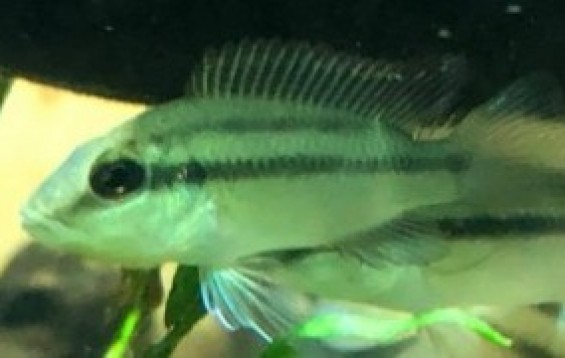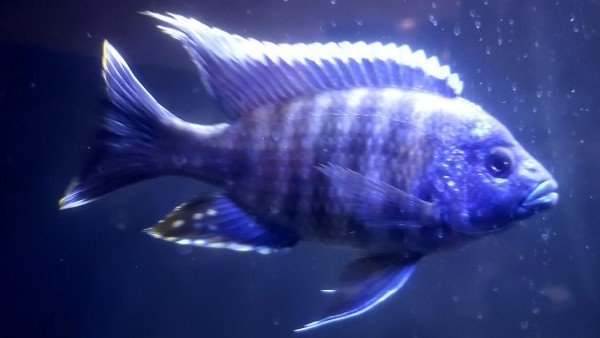- Name:
Guenthers Mouthbrooder
- Family: Cichlidae
- Species: African Cichlids
- Scientific Name: Chromidotilapia guentheri


More Details
General info about Guenthers Mouthbrooder
Guenthers Mouthbrooder Cichlids are native to the Congo River Basin and prefer slow-moving, shallow rivers and streams with lots of vegetation. They prefer water temperatures of 75-82°F and a pH range of 6.5-7.5.
Guenthers Mouthbrooder Cichlid (Chromidotilapia guentheri) is a species of African cichlids native to the Congo River Basin. They are a small to medium-sized species with males reaching up to 5 inches and females up to 4 inches. They are usually silver to gray in color with darker markings and a yellow-orange belly.
Differences between Guenthers Mouthbrooder Cichlid and other African Cichlids Guenthers Mouthbrooder Cichlid is unique among African cichlids in that it is a mouthbrooder species, which means that the female carries the eggs and fry in her mouth until they are ready to be released. This behavior is uncommon among cichlids and makes them a popular choice for aquariums. They are also more peaceful than many other African cichlid species, making them a good choice for community aquariums.
Guenthers Mouthbrooder Diet & Nutrition
Guenthers Mouthbrooder Cichlids are omnivores and should be fed a varied diet of frozen and live foods, including brine shrimp, bloodworms, daphnia, and other small invertebrates. They also appreciate vegetable matter such as algae wafers and blanched vegetables.
Determining Sex of Guenthers Mouthbrooder
Males and females of this species have different color patterns. Males are typically larger than the females and will have more intense colors. Males also have more pointed dorsal and anal fins than the females.
Breeding & Spawning Guenthers Mouthbrooder
To breed Guenthers Mouthbrooder Cichlids, a pair of adults should be chosen and placed in a separate breeding tank. The water parameters should be monitored and adjusted to the ideal levels. Once the pair has spawned, the female will carry the eggs and fry in her mouth until they are ready to be released.
Tips for Successful Breeding To ensure successful breeding, the pair should be healthy and in good condition. The water parameters should be monitored and kept at the ideal levels. A breeding tank should also be set up with plenty of hiding places and plants for the fry to hide in. Finally, the pair should be fed a nutritious diet to ensure good health and fertility.
Common Diseases with Guenthers Mouthbrooder
Like other aquarium fish, Guenthers Mouthbrooder Cichlids are susceptible to various diseases, including bacterial infections, fungal infections, and parasites. These can be prevented or treated with proper tank maintenance and water conditions, as well as the use of medications.
To prevent or treat diseases, regular cleaning and maintenance of the aquarium is essential. This includes water changes, cleaning the substrate, and removing any detritus from the tank. Monitoring water parameters and adjusting them to the ideal levels can also help prevent diseases. In case of infection, medications can be used to treat the disease.
Guenthers Mouthbrooder Origin
Guenthers Mouthbrooder Cichlids are native to the Congo River Basin in Central Africa. They are found in slow-moving, shallow rivers and streams with lots of vegetation.
Popularity Among Aquarists Guenthers Mouthbrooder Cichlids have become increasingly popular among aquarists due to their peaceful nature and unique mouthbrooding behavior. They are a hardy species that can be kept in a wide range of water parameters, making them ideal for beginner aquarists.
Caution with Guenthers Mouthbrooder
When keeping Guenthers Mouthbrooder Cichlids, it is important to consider potential issues such as aggression between males, and the spread of diseases from other fish. To prevent these problems, it is important to provide adequate space for the fish and to monitor the water parameters closely.
Careful Monitoring of Water Parameters Guenthers Mouthbrooder Cichlids are sensitive to water parameters, so it is important to monitor these closely. The ideal water temperature should be between 75-82°F and the pH should be between 6.5-7.5. Regular water changes and maintenance of the aquarium can also help to keep the water parameters stable.
Acclimating Guenthers Mouthbrooder
Acclimating Guenthers Mouthbrooder Cichlids to a new aquarium should be done slowly and carefully. The fish should be placed in a separate container with water from the aquarium, and the water in the container should be changed every 15-20 minutes. This process should be done for 1-2 hours before the fish are released into the aquarium.
Once the Guenthers Mouthbrooder Cichlids have been acclimated to the aquarium, it is important to provide them with a healthy environment. This includes monitoring water parameters, providing adequate space, and providing plenty of hiding places and plants for the fish. Feeding them a nutritious diet and regularly cleaning the aquarium are also important for their health and well-being.
Relevent Articles
Original Detail
| Name | Species | Family | Scientific Name | More Detail | Added by |
|---|---|---|---|---|---|
| Guenthers Mouthbrooder | African Cichlids | Cichlidae | Chromidotilapia guentheri | Guenthers Mouthbrooder Cichlids are native to the Congo River Basin and prefer slow-moving, shallow rivers and streams with lots of vegetation. They prefer water temperatures of 75-82°F and a pH range of 6.5-7.5. Guenthers Mouthbrooder Cichlid (Chromidotilapia guentheri) is a species of African cichlids native to the Congo River Basin. They are a small to medium-sized species with males reaching up to 5 inches and females up to 4 inches. They are usually silver to gray in color with darker markings and a yellow-orange belly. Differences between Guenthers Mouthbrooder Cichlid and other African Cichlids Guenthers Mouthbrooder Cichlid is unique among African cichlids in that it is a mouthbrooder species, which means that the female carries the eggs and fry in her mouth until they are ready to be released. This behavior is uncommon among cichlids and makes them a popular choice for aquariums. They are also more peaceful than many other African cichlid species, making them a good choice for community aquariums. | PalaciosAn |
Changed by users
| Submitted Date | Submitted By | Status | Action |
|---|






